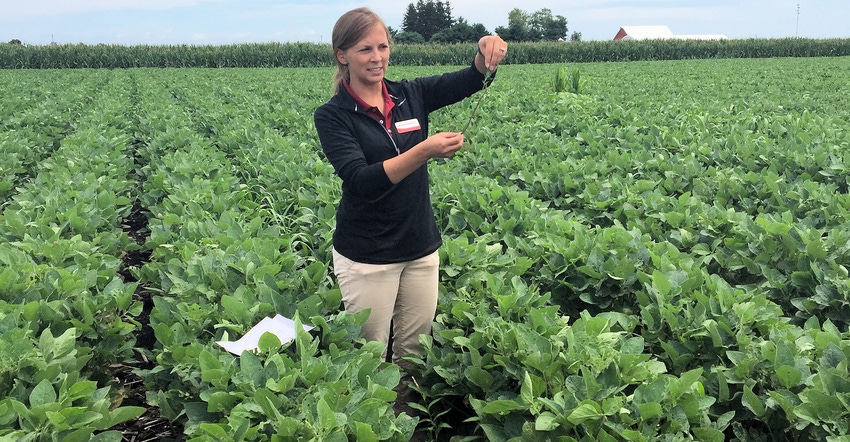January 11, 2017

By Rebecca Vittetoe
Using herbicides to manage weeds is a relatively simple system. It provides farmers with more time to manage weeds, less soil disturbance and a high efficacy against target weeds. This system is also relatively simple for weeds to overcome through resistance, and weed resistance to herbicides comes with a big price tag.
Herbicide resistance costs farmers $20 to $60 or more per acre, according to a recent study by USDA’s Economic Research Service (see ers.usda.gov).
The cost of diversifying weed management programs to prevent resistance is more economical than managing resistant weeds with fewer herbicide options. Once weed resistance occurs, it will likely remain in a field forever.
Weeds Week is an ISU program that addresses herbicide resistance and develops long-term weed management strategies. ISU Extension field agronomists conducted this year’s workshops at five locations from July 18 to 22. Primary goals were to increase knowledge and awareness about herbicide resistance and management of herbicide-resistant weeds.
What causes resistance?
Herbicides have not caused weed resistance issues; rather, natural mutants in a weed population carry a gene making that weed resistant to the herbicide product being applied. With repeated use of a single herbicide group, selection pressure is put on the weed population for the mutant weed with resistance to persist and multiply. It doesn’t matter what specific herbicide product is used. If the same product is used repeatedly, resistance will develop.
There are steps you should be taking to prevent herbicide resistance.
Know your enemy. What are the problem weeds on your farm? Knowing what weed spectrum you are dealing with can help you tailor a herbicide program to work well against your problem weeds. Understand the difference between herbicide mode of action and site of action.
MOA or SOA. There is often confusion about the difference between MOA and SOA. Many people use these terms interchangeably. You must differentiate between the two.
The MOA - or mode of action - of a herbicide refers to the effect the herbicide has on plant growth. SOA - site of action - refers to the specific location within the plant that the herbicide binds to. SOA are subsets of MOA and are also referred to as herbicide groups.
Two herbicides with different herbicide groups will bind to different locations to kill a plant. Knowing the herbicide group (SOA) is critical to using effective products and designing a resilient herbicide program. It is much easier for farmers now that most herbicide labels list the herbicide group on the front.
Use multiple and effective sites of action. The next step is to use multiple herbicide groups that are effective against your target weeds to delay or prevent resistance development. Another part of using effective sites of action is using effective herbicide rates. This requires taking a look at how much of the actual active ingredient is included in a herbicide product.
Timing is also a critical component. Newly germinating or small weeds are significantly easier to kill than weeds over 6 inches in height. Part of the timing component is not relying on just one herbicide application.
Start off with a weed-free seedbed in spring by using tillage or an appropriate burndown application. Next, apply a full-rate of an effective preemergence herbicide as close to final seedbed preparation as possible, followed by a timely post-emergence herbicide application.
Layering a residual herbicide with the postemergence herbicide application is a way to provide longer management of late-germinating weeds, like waterhemp. This can be especially effective with Group 15 herbicide products because of their relatively short residuals.
Integrate other weed management tactics into your weed management plan. Looking ahead, the likelihood of a new herbicide group entering the market in the near future is very slim, which means our options are likely limited to the herbicide groups that are available today.
Farmers need to be hands-on with weed management, whether managing existing resistances or preventing new resistances from becoming a problem. Other weed management tactics, like increasing crop competitiveness, rotating crops and using mechanical weed management will be important to supplement chemical tactics to prevent the complete breakdown of the usefulness of herbicides.
Putting all of these pieces together to develop a long-term weed management plan requires asking the right questions to determine what is right for your farm this year. This is not necessarily the same thing that was right for your farm or field last year, or is right for your neighbor’s field. There is no one silver bullet when it comes to weed management.
Some resources you may find helpful in creating a weed management program:
2016 Herbicide Guide for Iowa Corn and Soybean Production
Iowa State Weed Science website
Vittetoe is an ISU Extension field agronomist covering southeast and south-central Iowa. Contact her at [email protected]
You May Also Like




